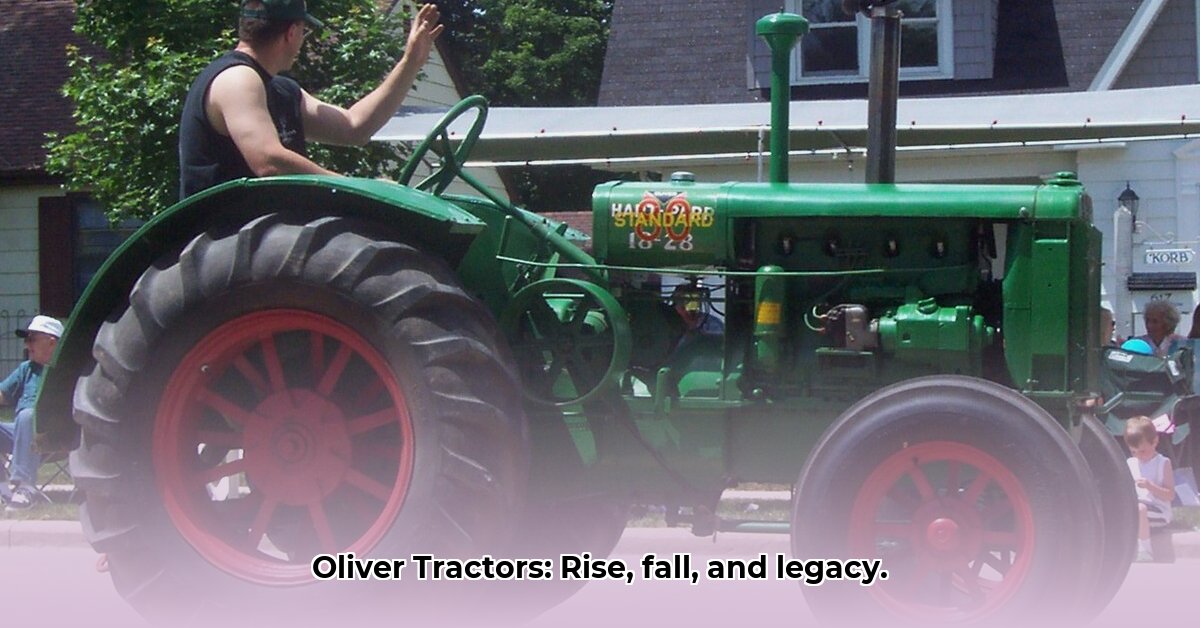
The story of Oliver tractors is a compelling narrative of agricultural innovation, strategic mergers, intense competition, and ultimate decline. It's a tale that reflects not only the evolution of farming technology but also the complex dynamics of the American business landscape in the 20th century. This history offers valuable lessons for businesses navigating the challenges of technological disruption and fierce competition. How did a company that once dominated the agricultural equipment market eventually fade from view? Let's delve into the fascinating story of Oliver. For example, see this 1959 Oliver 550.
The Genesis of a Giant: Early Mergers and Market Dominance
The Oliver Farm Equipment Company wasn't born from a single visionary but from a shrewd strategic merger in 1929. Four distinct companies – Oliver Chilled Plow, Hart-Parr, Minneapolis Threshing Machine Company, and Advance Rumely Thresher Company – combined their expertise to create a "full-line" supplier of agricultural equipment. This bold move provided farmers with a one-stop shop, ranging from plows to threshing machines, and proved incredibly successful. This early strategy—offering a comprehensive suite of products— instantly catapulted Oliver to a leading position in the industry. But did this initial success foreshadow future triumphs, or did it plant the seeds of future struggles?
The Golden Age of Oliver: Post-War Prosperity and Technological Advancements
Oliver's early success coincided with the post-war boom in American agriculture. The demand for efficient agricultural machinery skyrocketed and Oliver responded with continuous improvements to its tractors and other equipment. Their reliable and constantly refined machines became ubiquitous on farms across the nation, significantly improving farming productivity. This period of rapid growth and technological leadership firmly established Oliver as an industrial giant. Yet, this period of seemingly unassailable dominance belied underlying vulnerabilities. What were the early warning signs that this prosperity wouldn't last forever?
Shifting Sands: Increased Competition and Evolving Market Dynamics
The post-war agricultural boom did not last indefinitely. The evolution of farming practices, the emergence of new technologies, and aggressive competition from industry titans like John Deere and International Harvester fundamentally altered the playing field. Oliver, once the undisputed leader, now faced a much more challenging environment. Some historians argue that Oliver's response to this intensified competition was too slow, that it failed to adapt to the rapidly changing needs of farmers and the innovative strategies employed by its competitors. Others suggest that external market forces beyond Oliver's control played a more significant role. This pivotal period raises important questions about the company's strategic decision-making and its capacity for dynamic adaptation. Was it a matter of lagging innovation or simply an unavoidable shift in market dynamics?
A Pivotal Acquisition: The White Motor Corporation Merger
In 1960, Oliver Farm Equipment was acquired by the White Motor Corporation, a company primarily focused on the truck manufacturing industry. This wasn't a merger of equals; it was an acquisition driven by White Motor's diversification strategy. While initially promising, this event ultimately proved to be a watershed moment in Oliver's history. The acquisition resulted in a gradual decline of the Oliver brand, despite the enduring quality of its machinery. This event serves as a critical case study on the potential pitfalls of corporate mergers and the complexities of integrating disparate companies. What were the unforeseen consequences of this seemingly strategic acquisition?
The Enduring Legacy: A Lasting Impact on American Agriculture
While new Oliver tractors are no longer manufactured, the company's contribution to American agriculture remains undeniable. Many Oliver tractors continue to operate on farms across the country, cherished by their owners and meticulously maintained by a dedicated community of collectors and restoration enthusiasts. These machines represent a tangible testament to the ingenuity and durability of Oliver's engineering, a lasting legacy of a bygone era. How did Oliver's engineering prowess create a legacy that outlives the company itself?
Unanswered Questions and Future Research
Despite a broad understanding of Oliver's history, critical gaps in information remain. Access to comprehensive sales figures, financial records, and internal company documents would allow for a much more nuanced understanding of Oliver's performance relative to its competitors and the internal decision-making processes that shaped its fate. Further research into these areas is crucial to fully appreciate the complexities of Oliver's rise and fall. This limitation in available data highlights the ongoing need for scholarly investigation focused on this significant piece of agricultural history.
Diverse Perspectives on the Oliver Legacy
The Oliver legacy resonates across various stakeholder groups, each with unique perspectives and long-term goals. We can consider these different perspectives to achieve a more well-rounded view of the Oliver story. How do different perspectives shape our understanding of Oliver's overall significance?
| Stakeholder | Short-Term Goals | Long-Term Goals |
|---|---|---|
| Agricultural Historians | Analyzing available data; Identifying new sources of information. | Creating comprehensive historical accounts of agricultural technology. |
| Business Strategists | Analyzing Oliver's strategic decisions; Identifying implications for modern business. | Developing frameworks for successful adaptation in dynamic markets. |
| Museum Curators | Acquiring and preserving Oliver artifacts; Curating exhibits. | Educating the public on the history of agricultural technology. |
| Collectors/Restorationists | Restoring and maintaining Oliver equipment; Sharing knowledge. | Preserving Oliver's legacy through active documentation and community engagement. |
The story of Oliver is more than just a historical account; it's a compelling case study in business strategy, adaptation, and the challenges inherent in maintaining market dominance in a dynamic and competitive landscape. Oliver's legacy serves as a powerful reminder of the importance of innovation, strategic planning, and agile adaptation in ensuring long-term success. The enduring presence of Oliver tractors on farms across America stands as testament to their engineering prowess and a lasting impact on the agricultural landscape.